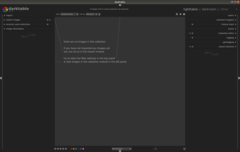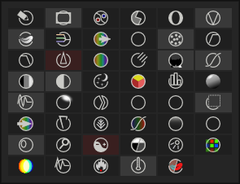Darktable
This article relies too much on references to primary sources. (December 2013) |
 Screenshot of Darktable 3.6.0, darkroom view | |
| Original author(s) | Johannes Hanika[1] |
|---|---|
| Initial release | April 2009[2] |
| Stable release | |
| Repository | github |
| Written in | C and GTK |
| Operating system | FreeBSD Linux macOS Solaris Windows |
| Platform | x86-64, ARM64 |
| Size | 3.26 MB (source) 61.8 MB (Windows) 56 MB (macOS) |
| Available in | 26 languages[5] |
| Type | Photo post-production |
| License | GPL-3.0-or-later[6] |
| Website | www |
Darktable (stylized as darktable) is a free and open-source photography application software and raw developer. Rather than being a raster graphics editor like Adobe Photoshop or GIMP, it comprises a subset of image editing operations specifically aimed at non-destructive raw image post-production. It is primarily focused on improving a photographer's workflow by facilitating the handling of large numbers of images. It is freely available in versions tailored for most major Linux distributions, macOS, Solaris and Windows and is released under the GPL-3.0-or-later.[6]
Features[]
Darktable involves the concept of non-destructive editing, similar to that of some other raw manipulation software. Rather than being immediately applied to raster data of the image, the program keeps the original image data until final rendering at the exporting stage — while parameter adjustments made by a user display in real-time. The program features built-in ICC profiles, GPU acceleration (based on OpenCL), and supports most common image formats.
Main features[]
- Non-destructive editing with the XMP change description entry
- Work in 32-bit float mode on a color channel in CIE LAB space
- Full implementation of color management
- Supports RAW, JPG, RGBE, PFM and more
- Completely modular architecture
- More than 30 modules for transformation, color correction, quality improvement and artistic effects
- Organize images and search by parameters
- Translated into 19 languages
- Support for shooting directly through the camera
- Find similar photos
- Support for geographical coordinates labels with the display of photos on the map
- Export to Flickr and Facebook
- An integrated mover for executing Lua scripts. Scripts can be linked to hotkeys or specific events, such as when importing new images.
Masks[]
Support for drawn masks was added in Darktable version 1.4, allowing application of effects to manually specified areas of an image. There are five mask types available: brush, circle, ellipse, bezier path, and gradient; all are resizable, allow fade-out radius for smooth blending and can have their opacity controlled. An arbitrary number of masks can be created and are collected into a "mask manager" on the left hand side of the darkroom UI.[7]
Color[]
Darktable has built-in ICC profile support for sRGB, Adobe RGB, XYZ and linear RGB color spaces.[8]
Importing and exporting[]
Raw image formats, JPEG, HDR and PFM images can be imported from disk or camera, and exported to disk, Picasa Web Albums, Flickr, email, and to a simple HTML-based web gallery as JPEG, PNG, TIFF, WebP, PPM, PFM and EXR images.[9] Images can be exported to Wikimedia Commons using an external plugin.[10]
Scripting[]
Darktable can be controlled by scripts written in Lua version 5.2. Lua can be used to define actions which Darktable should perform whenever a specified event is triggered. One example might be calling an external application during file export in order to apply additional processing steps outside of Darktable.[11]
Multi-mode histogram[]
Multiple histogram types are available, all with individually selectable red, green and blue channels: linear, logarithmic and waveform (new in version 1.4).[7]
User interface[]



Darktable has two main modes: lighttable and darkroom. Each represents a step in the image development process. Two more modes are tethering and a map view. Upon launching, lighttable opens by default, where image collections are listed. All panels in all modes can be minimized to save screen real estate.[12]
Lighttable[]
The left panel is for importing images, displaying Exif information, and filtering. Rating and categorizing buttons are at the top, while the right-side panel features various modules such as a metadata editor and a tag editor. A module used to export images is located at the bottom-right.
Darkroom[]
The second mode, "darkroom", displays the image at center, with four panels around it; most tools appear on the right side. The left panel displays a pannable preview of the current image, an undo history stack, a color picker, and Exif information. A filmstrip with other images is displayed at the bottom, and can be sorted and filtered using lists from the upper panel. The latter also gives access to the preferences configuration. Darktable's configuration allows custom keyboard shortcuts and personalized defaults.
Tethering[]
The third mode allows tethering through gPhoto to some of the cameras which support it.[13]
Map[]
The fourth mode can display maps from different online sources and geotags images by drag-and-drop. It also uses maps to show images already geotagged by a camera.
Plugins[]


As of December 2019, darktable includes 67 image adjustment plugins, which it divides into 5 groups;[9]
Basic group[]
Plugins for simple well-known photo adjustment operations include: contrast brightness saturation module; shadows and highlights; color reconstruction; base curve with presets to automatically improve contrast and colors; crop and rotate; orientation; exposure; demosaic; highlight reconstruction; white balance; invert and raw black/white point.
Tone group[]
Plugins related to contrast and lighting include: fill light for modifying the exposure based on pixel lightness; levels to set black; tone curve; zone system; filmic; local contrast; global tone mapping and tone mapping.
Color group[]
Plugins related to hue and saturation include: velvia, which mimics Velvia film colors by increasing saturation on lower saturated pixels more than on highly saturated pixels; channel mixer; output color profile; color contrast; color correction, to modify the global saturation or to give a tint; monochrome; color zones; color balance; vibrance; color look up table; input color profile and unbreak input color profile.
Correction group[]
Plugins for repairing visual imperfections include: dithering; sharpen; equalizer; denoise (non-local means); defringe; haze removal; denoise (bilateral filter); scale pixel; rotate pixels; liquify; perspective correction; lens correction using the LensFun library; retouch; spot removal; denoise (profiled); raw denoise; hot pixels and chromatic aberrations.
Effect group[]
Artistic postprocessing plugins used for visual effects include: watermark; framing; split-toning; vignetting; soften; grain; highpass; lowpass; lowlight vision; bloom; color mapping; colorize and graduated density.
Development[]
Google Summer of Code[]
In 2011, the Darktable team participated in the Google Summer of Code (GSoC). The main goals were to remove libglade dependency from Darktable and to make room for more modularity. The input system for handling shortcuts was also rewritten and incorporated into version 0.9.[14][15]
Distribution[]
Darktable is released under the GPL-3.0-or-later as free software.[16] The current version of Darktable works on Linux, macOS and Windows. Many Linux distributions include Darktable in their default repositories, including Debian, Fedora, openSUSE, Arch Linux, and Gentoo Linux.
Darktable also runs on Solaris 11,[17] with packages in IPS format available from the maintainer.[18]
See also[]
- Adobe Photoshop Lightroom
- Comparison of raster graphics editors
- Rawstudio
- RawTherapee
- UFRaw
References[]
- ^ "contact". Darktable.org. Archived from the original on 2012-03-21. Retrieved March 16, 2012.
- ^ "Darktable main repository". Darktable.org. Archived from the original on 2017-01-19. Retrieved August 23, 2012.
- ^ "darktable 3.6.0 released". Retrieved July 5, 2021.
- ^ Nestor, Marius (2021-07-03). "Darktable 3.6 Open-Source RAW Image Editor Released with Many New Features". 9to5linux. Retrieved 2021-07-04.
- ^ "LINGUAS". Darktable.org. Retrieved February 4, 2016.
- ^ Jump up to: a b "about". Darktable.org. Archived from the original on 2012-03-07. Retrieved March 15, 2012.
- ^ Jump up to: a b Willis, Nathan. "Darktable 1.4". Archived from the original on 2014-05-02. Retrieved April 30, 2014.
- ^ "Archived copy". Archived from the original on 2018-01-14. Retrieved 2018-01-13.CS1 maint: archived copy as title (link)
- ^ Jump up to: a b "features". Darktable.org. Archived from the original on 2013-04-17. Retrieved March 15, 2012.
- ^ "DtMediaWiki". Retrieved October 14, 2018.
- ^ "Darktable user manual chapter 7". Darktable.org. Archived from the original on 2017-11-17. Retrieved April 30, 2014.
- ^ Schroder, Carla. "A RAW Feast on the Linux Darktable (Photo Editor)". Archived from the original on May 7, 2012. Retrieved April 28, 2012.
- ^ Schroder, Carla. "How to Remote Control Your Camera with Darktable on Linux". Archived from the original on May 2, 2014. Retrieved April 30, 2014.
- ^ "Who's New in Google Summer of Code: Part 7". Google Open Source Blog. Archived from the original on 2011-07-29. Retrieved 2012-03-15.
- ^ "Glade Removal Complete, Moving on to Keyboard Accelerators". Archived from the original on 2013-03-30. Retrieved 2012-03-17.
- ^ "GNU General Public License". Free Software Foundation. June 2007. Archived from the original on 2012-12-17. Retrieved August 23, 2012.
- ^ "Darktable and Solaris: It Just Works(tm) .... and there are some nifty benefits too". Archived from the original on 2012-09-15. Retrieved August 23, 2012.
- ^ "www.jmcpdotcom.com/Packages". Archived from the original on 2013-12-22. Retrieved 2012-07-25.
Bibliography[]
- Вейч, Ник (2010). "Darktable". Linux Format, русская редакция (in Russian). Saint Petersburg, Russia. 130 (4): 97. ISSN 1062-9424.
External links[]
| Wikimedia Commons has media related to Darktable. |
- Official website

- Darktable usermanual in English (also available in French, Italian, and German)
- darktable on GitHub
- Darktable (in Russian)
- Darktable (in Spanish)
- Tutorials
- Short and easy RAW development and Gimp integration tutorial
- Free photo software
- Free software programmed in C
- Graphics software that uses GTK
- MacOS graphics software
- Photo software for Linux
- Raw image processing software
